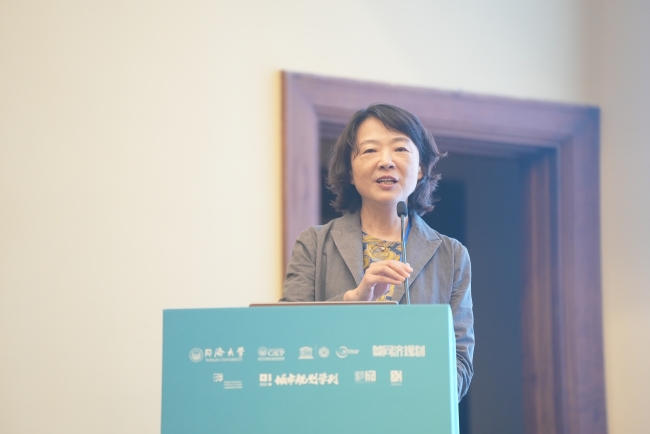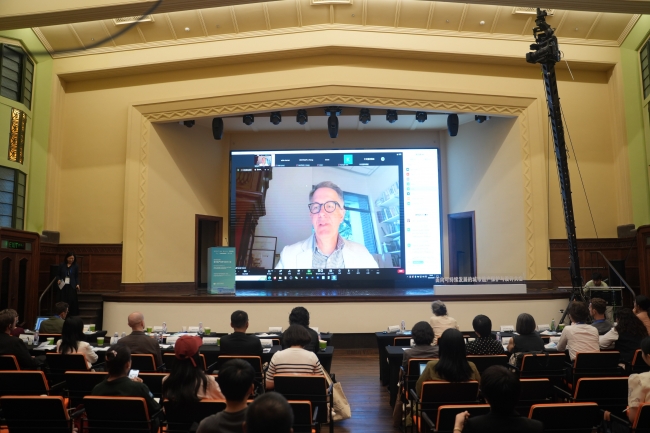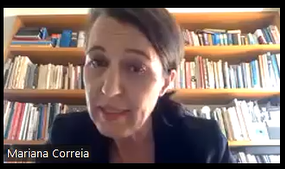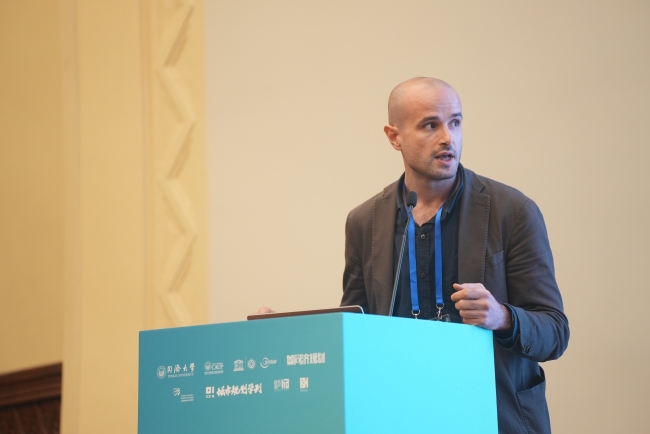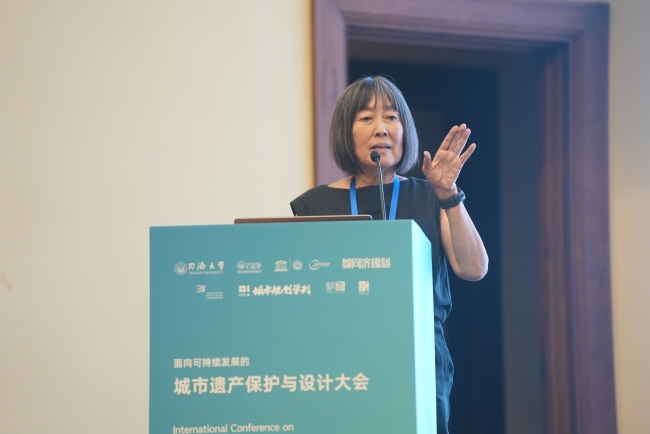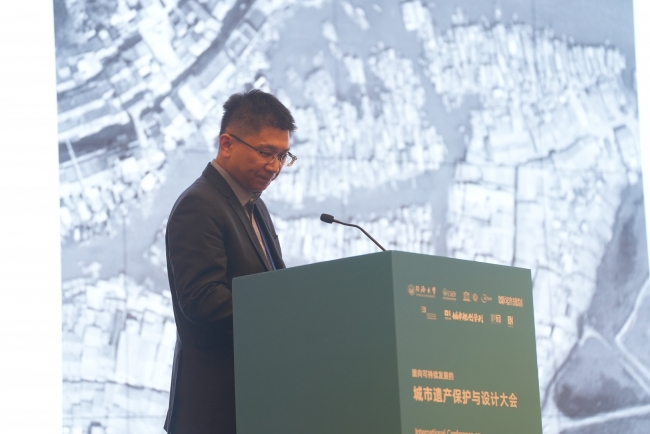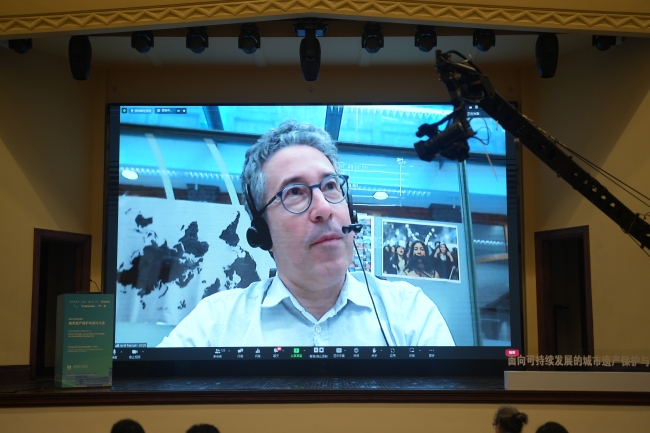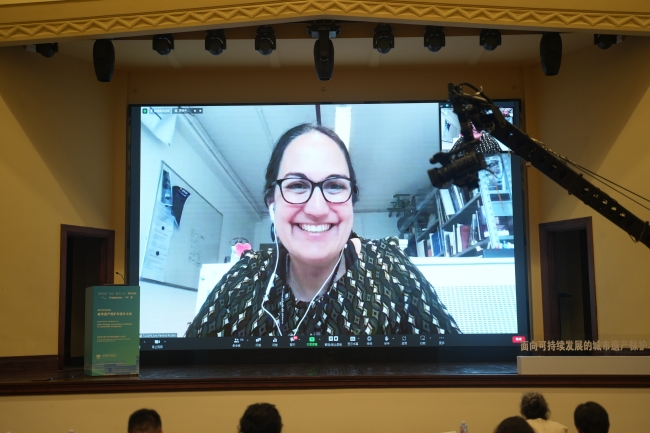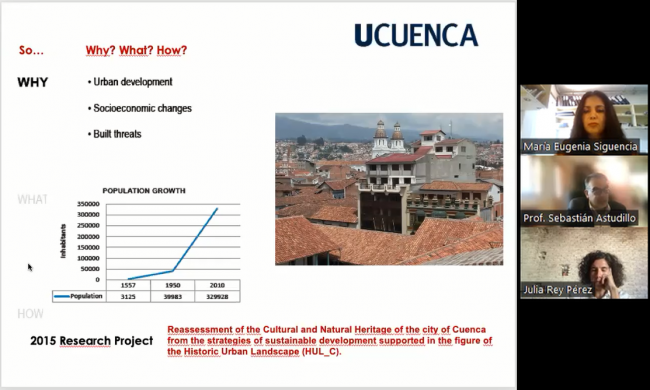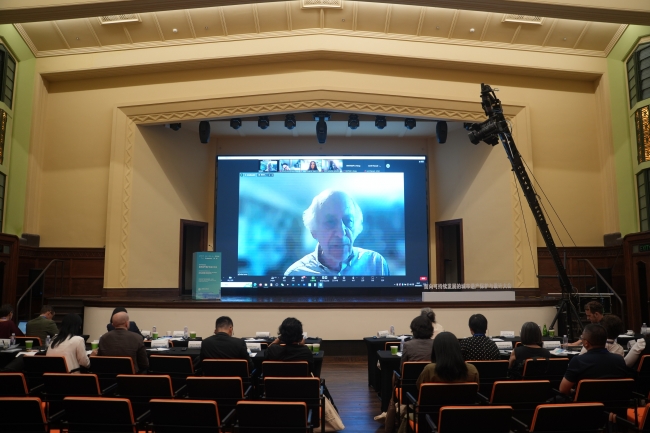| REVIEW | Summary of Thematic Session One during the International Conference on Urban Heritage Conservation and Design for Sustainable Development |
| PublishDate:2023-10-20 Hits:1751 |
From 26 to 28 September 2023, the “International Conference on Urban Heritage Conservation and Design for Sustainable Development” and the first meeting on the establishment of the International Network for Urban Heritage Conservation in Higher Education Institutions were successfully held at the historic building of the former Lester Institute of Technical Education at Design Innovation Institute Shanghai and the Wenyuan Building at Tongji University campus. The conference was hosted by Tongji University and co-organized by the College of Architecture and Urban Planning (CAUP), World Heritage Institute of Training and Research for the Asia and Pacific Region (Shanghai), a Category 2 Centre under the auspices of UNESCO (WHITRAP Shanghai), and Shanghai Tongji Urban Planning and Design Institute Co., LTD (TJUPDI). The event was also presented as a forum during the 2023 World Design Cities Conference.
The conference comprises four sections: the opening ceremony, keynote speeches, three thematic sub-forums, and the closing ceremony. The Topic One sub-forum on the evening of 26September was moderated by Prof. Shao Yong, Executive Director of WHITRAP Shanghai. Nine speakers from China, the United States, Portugal, Italy, Japan, Macau SAR, Spain, the Netherlands and Ecuador presented at the session on the topic of “Interdisciplinary Research: Implementing the UNESCO Historic Urban Landscape approach, theory and practice”.
Four Dimensional City: The Theory, Methods and Practice of the Urban Built Environment
He Yi Professor of School of Architecture and Urban Planning of Huazhong University of Science and Technology
Professor He Yi from the School of Architecture and Urban Planning at Huazhong University of Science and Technology presented her research progress on the "Four Dimensional City: The Theory, Methods and Practice of the Urban Built Environment". She first brought attention to "minor architecture" which was not defined as monuments within the context of "built heritage". She then expounded on this concept with the "four-dimensional city". The conservation value of "implicit historical elements" is thus proposed in this work, adopting a perspective based on spatial relationships. The essential methods of historical pattern translation and architectural texture analogy have significant practical implications for the preservation and demolition of urban structures. She used a range of Chinese and international examples to emphasize the role and importance of "historical presence" in the spatial and temporal development. She introduced the theoretical concept of the four-dimensional city, beginning with the spatialization and temporalization of space-time, and then delved into the topic of historical texture. The term "texture unit" was introduced and popularized in home building, serving as the foundation for applying the principle of architectural typology and allowing the conversion of an "archetypal" unit into a "type" unit. During this process, the architectural unit experiences change, while the spatial relationships remain constant. The most significant technological challenge is to determine the "scale" of conversion using the "archetype-typology-heterotype" identification process. She has identified two distinct texture types, namely "isomorphic type-like" and "similarity type-like", from the perspectives of time and space. Additionally, a case study was conducted on the planning for the Nanhuamen Historic District, highlighting the usefulness of this research. Finally, it was emphasized that urban growth has a unique life cycle which leaves behind cultural traces that generate the "cultural layers". The “layering of history” should form the basis for the preservation and development of historic towns, exposing their internal development rationale and attaining goals linked to landscape management and control.
Getting Creative about Governance
Randall Mason University of Pennsylvania, Weitzman School of Design
Professor Randall Mason of the University of Pennsylvania presented a lecture on the topic of "Getting Creative with Governance". He raised a few concerns about the issues of governance that are critical in the implementation of the historic urban landscape. He also emphasized the growing importance of addressing governance issues in diverse social contexts, particularly in heritage conservation education. Professor Mason defined governance as a collective means of managing the environment and society. He distinguished between governance and government, and subsequently presented three essential issues about governance. The first pertains to the challenge of integration. Drawing upon the example of the streets in Philadelphia, he emphasized the need to shift from viewing historic preservation or heritage conservation as a discipline or a field to viewing it as a larger community of practice with many shared ideas rather than a few silo ideas. The second issue concerns property ownership, exemplified by the case of gentrification in Philadelphia’s neighborhoods, posing specific governance challenges in balancing public and private benefits, as well as economic and cultural outcomes. He encourages creativity in developing new senses of ownership and exploring novel tools of governance, while being mindful of emerging practices in interdisciplinary practices. The third concern relates to the issue of growth. He believes that the emphasis on growth and design responses will probably persist in the new narrative about sustainable development. To succeed, it must prioritize inheritance and conservation and foreground governance. Professor Mason ultimately pointed out that while integration could be improved in the short term, the challenges of ownership and growth are long-term and will not immediately change. Therefore, we must consider both the present and the far future. It is crucial for professionals in the field of heritage conservation to comprehend these problems in the context of managing urbanism over a longer period of time.
Experiences from the Past for Tomorrow’s Challenges
Mariana Correia Director of the Department of Architecture and Multimedia Gallaecia (DAMG) at Universidade Portucalense Infante D. Henrique (UPT) and the Director of the Research Centre
Ms. Correa began by outlining the plight of vernacular building practices and traditional ways of life that are gradually disappearing as a result of technological advancements, the emergence of new materials, and globalization. Afterwards, she systematically presented the four primary sections of the presentation. In the first section about vernacular architecture, she defines vernacular architecture as "buildings that are not formally planned but possess inherent cultural and intellectual value". She contends that vernacular architecture has the potential as a solution to sustainability by taking into account social factors, energy efficiency, tradition, and the environment. The VerSus project in Europe offers as an example of acknowledging principles anchored in vernacular knowledge. A more inclusive and holistic approach is necessary to improve the sustainable development of our neighborhoods. The advantages of community involvement were highlighted in the second section, emphasizing its role in fostering social cohesion, preserving traditional ways of life, and promoting social integration. She further emphasized the importance of community cohesion, demonstrating this through examples of collective water usage and collaborative housing construction. In the third section, it was suggested that maintaining local sustainability requires social and cultural harmony as well as local technology connected to intangible heritage. It has been suggested that developing strategies to preserve the distinct architectural culture of each region by identifying local technologies is essential. In the fourth section, which discussed education and research, the argument is made that many architects and engineers working on heritage restoration projects have opted to demolish sections of interior building spaces because they have a poor understanding and appreciation of local architectural knowledge. These parts were subsequently replaced with modern materials. The curricula of architectural schools can have a significant impact on the understanding of traditional building systems, regional skills, and the specific qualities of vernacular architecture. To conclude, Ms. Correa advocated increased engagement in sustainable development through greater community involvement, valuing local technology and assuming social responsibility.
From the Other to the Self: Interdisciplinary Insights at the Root of the Idea of Urban Heritage
Jacopo Benedetti Postdoctoral Fellow at the College of Architecture and Urban Planning (CAUP) of Tongji University
Jacopo Benedetti, a postdoctoral fellow at CAUP of Tongji University delivered a presentation titled "From the other to the self. Interdisciplinary Insights at the Root of the Idea of Urban Heritage". The presentation begins by acknowledging how urban heritage has first been defined, in the late 19th century, as that which was other than the contemporary processes of urbanization (i.e., the self): paraphrasing Françoise Choay, the historic city has been conceptualized not for what it was, but rather for what it wasn’t. One of the first attempts to provide a positive definition of urban heritage can be traced back to a classic of modern city planning: Camillo Sitte’s Der Städtebau nach seinen künstlerischen Grundsätzen - or The Art of Building Cities (1889). This analysis of the artistic reception of historic cities has been an unavoidable reference for 20th century urbanism, serving as either a model or a counterexample. Often deemed by its detractors as formalist or historicist, it is often neglected how Sitte’s study also embodied a groundbreaking interdisciplinarity. Through the writings of German architect Hermann Maertens, Der Städtebau borrowed insights and concepts from late-19th-century optical physiology – especially from Hermann von Helmholtz’s seminal Handbuch der physiologischen Optik: the same body of research that would serve as breeding ground for the birth of experimental psychology. In other words, in Camillo Sitte’s writings we can witness an unexpected convergence between two contemporary thought revolutions: the invention of urban heritage and the invention of the sciences of the mind. We can follow the consequences of this convergence throughout the course of the 20th century, in authors such as August Schmarsow, Albert Erich Brinckmann, Gustavo Giovannoni, Nikolaus Pevsner, Bernhard Hoesli, Gyorgy Kepes, Kevin Lynch, and Christopher Alexander, among many others. Even today, facing the extraordinary developments of the cognitive sciences and neurosciences, the same interdisciplinary thread of research offers novel interpretive keys and operational tools for questioning the perception, recognition, and appropriation of urban heritage, addressing some of the open challenges of the Historic Urban Landscape approach.
Necessity of Interdisciplinary Collaborative Researchers’ Response to the Needs of Local Heritage Management
Nobuko Inaba Professor Emeritus at University of Tsukuba, Special Advisor to the Director General of ICCROM.
Professor Nobuko Inaba began her presentation by addressing the translation considerations of the heritage conservation concepts in Japanese. She stated that, in Japan, there are no distinct physical markers between urban and rural areas. While each municipality in Japan today is defined solely by its population, density, and the ratio of vocations that match to the demands of administrative management, despite the fact that their historical origins are distinct. It is often challenging to distinguish clearly between mid-size cities, towns, and villages in terms of heritage management viewpoints, with the exception of major cities like Tokyo, Osaka, or Kyoto. Then, it was revealed that the cultural heritage protection system in Japan encompasses not only classical types of cultural heritage but also natural heritage and landscapes as well as intangible heritage. To ensure successful management of these heritage concepts, integration and decentralization of decision-making to the local level, the closest level to the public, is necessary. An advantage of this interdisciplinary partnership is successful heritage management. Japan's cultural heritage management is currently devoted to implementing an integrated strategy that connects natural and cultural heritage. The Law for the Protection of Cultural Properties has undergone three revisions in 2004, 2007, and 2008, and Japan completed the most recent revision in 2018. This legislation served as the legal foundation for "Comprehensive Cultural Properties Protection and Management Local Plan" at the municipal-level. The aim of this plan is to identify and map cultural and natural resources, conserve them, and utilize heritage. The policy has directed the establishment of local government units within the context of sustainable development, shifting from spot conservation to integrated territorial conservation, and adhering to the policy direction on heritage resource management. This shift contributes to the sustainable development of local government's capacity. Lastly, Professor Nobuko Inaba shared a case study on cultural resources undertaken by the Kita-Akita municipality. She stressed the necessity of interdisciplinary collaborative researchers’ response to the needs of local heritage management and capacity building. She encouraged joint research collaboration for heritage resource management.
The Configuration Mechanism of HUL Hierarchy and the Sustainable Strategy of Contemporary Urban Landscape in Macao
Zheng Jianyi Associate Professor, Faculty of Humanities and Arts, Macau University of Science and Technology
Professor Zheng Jianyi, Director of the Architecture Programme at the Faculty of Humanities and Arts, Macau University of Science and Technology, delivered a presentation on "The Configuration Mechanism of HUL Hierarchy and the Sustainable Strategy of Contemporary Urban Landscape in Macao". Following an overview and the history of Macau, he analyzed the urban landscape of Macau in detail. Using of Conzienian urban morphology approach, he identified three hierarchies of townscape composition that shaped Macau's historic landscape: street blocks expansion, residence repletion, and breakthrough street redevelopment. This in-depth examination demonstrates the continuity of Macau's urban development over 450 years and the characteristics of the collage urban landscape. Community cultural landscape is the contemporary component of HUL. It contributes to the conservation and continuation of the material landscape and revitalize the historic place. Consequently, he displayed a few sustainable practices adopted by Macao in tackling current challenges. Association is a distinctive element of HUL's sustainable development, with the public education and community building aiding in the understanding and participation of historic sites. For instance, the Macao Cultural Heritage Reinventing Studies Association has offered HUL Lessons/Workshop in Macao for high school students, as well as graduates and undergraduates in architecture and urban planning. The Macao Community Construction Promotion Association has provided professional and technical assistance to the revitalization of Pátiodo Espinho, and acted as a mediator to facilitate communication between the community, relevant government agencies, and other social groups. Digital technology is a valuable tool for conserving historic landscape. The research team, using key landmarks in Macao as an illustration, performed a computational analysis of view corridors to obtain accurate and overall characteristics of the area, building height limitations, and other essential indicators. This data can aid in the protection of historic urban landscapes in high-density urban settings.
A Cultural Boost in the Achievement of the SDGs: How Local and Regional Governments Are Promoting Cultural Heritage and Sustainable Cities and Territories
Jordi Pascual Coordinator of the Committee on Culture of the World Organisation of United Cities and Local Governments (UCLG)
In his presentation entitled "Cultural Boost in the Achievement of the SDGs: How Local and Regional Governments Are Promoting Cultural Heritage and Sustainable Cities and Territories," Jordi Pascual provided a concise overview of the goals, topics, and methodology of UCLG, followed by some remarks on the interconnectivity between culture and the SDGs. He argues that the SDGs that deal with culture are inadequate and do not give cultural actors and communities the support to accomplish their goals. As a result, UCLG is committed to equipping local government representatives with tools to facilitate cultural policy alignment with local implementation of and achievement of the SDGs. Cultural policies are closely linked with urban policies, urban planning, education, health and well-being, economic growth, and infrastructure in their local implementation. It is crucial that existing cultural policies consider the contribution of cultural action to the achievement of the Sustainable Development Goals (SDGs) as well as the role of cultural actors. Cultural policies must be reassessed based on their values and behavior. Cultural policies need to be re-evaluated based on their values and behavior. An instance of the negative impact of excessive tourism on the cultural life of residents in specific areas was cited. Additionally, women face limitations in participating in cultural activities in their communities due to the prejudice against them. Finally, Jordi emphasized the importance of cultural progress. While advancing culture is essential to achieving the 17sustainable development objectives, the 2030 Agenda urgently needs to include a cultural goal. Even if it may not be possible to include additional targets in the current framework for the SDGs, cultural development remains a pressing issue that has to be addressed.
The Historic Urban Landscape Approach
Ana Pereira Roders Professor in Heritage and Values, UNESCO chair on Heritage and the Reshaping of Urban Conservation for Sustainability, TU Delft
Ana Pereira Roders, a professor in Heritage and Values at Delft University of Technology in the Netherlands, delivered a presentation on the historic urban landscape approach. The presentation covered the team's research plan and her experiences and comments on heritage conservation theory and policy suggestions for historic urban landscapes, as well as the team's recent results. As a resource and asset that can be passed on to metropolitan are as, heritage has a variety of important values. What steps should be taken, nevertheless, if it is not listed on the protection list and the protection is not there? Her team's work involved attempting to comprehend a wider range of values and the traditional values associated with heritage regulations, since evidence over time has proven that many properties also feature more qualities than were initially acknowledged or formally recognized. She therefore made an effort to examine other initiatives in order to better comprehend and theorize the differences, not just in the tangible but also in the intangible aspects of those changes. Ana emphasizes that the Historic Urban Landscape (HUL) has been developed for all cities and is a long-term process that requires cross-sector collaboration from national to local levels, as well as interdisciplinary expertise. It is important to comprehend the values that are given priority in order to make informed decisions. It is crucial to deliberate on who should make decisions, based on what values, and how to implement swift and fair changes. Ana presented case studies from her team in cities throughout the world, with the goal of collaborating with local and national governments to improve and restructure their heritage planning. Methodological research and policy assessments, for instance, could delve into the impact of values on interventions in the built environment. In addition, artificial intelligence, social media, and online forums could be utilized to compare cities' universal ideals and cultural significance amidst different cities. A comparison between policy papers and literature along with social media might also give useful insights. Ana mentions that HUL is an ongoing effort to obtain a better understanding of how we evaluate cities and how this affects their preservation. This helps to advance the conservation cause and promote sustainable urban development.
The HUL Recommendation in Cuenca: Risks and Challenges in the Conservation of the Heritage City
Sebastian Astudillo Cordero Professor and Director of the Master in Conservation of Monuments and Sites, University of Cuenca Julia Rey Pérez Associate Professor in Architectural History, Theory and Composition Department at Higher School of Architecture at the University of Seville María Eugenia Siguencia PhD Architect, University of Cuenca
Sebastián Astudillo Cordero, a professor and Director of the Master in Conservation of Monuments and Sites at the University of Cuenca, along with his colleagues Julia Rey Pérez and María Eugenia Siguencia presented a lecture titled "The HUL Recommendation in Cuenca: Risks and Challenges in the Conservation of the Heritage City." The trio discussed the challenges faced by Cuenca in the past, present, and future. Cuenca underwent considerable social and urban transformation at the beginning of the project, in the midst of early economic fluctuations impacting the historic districts and their surroundings. The HUL Recommendation was made available to Cuenca as a tool for identifying the city's tangible and intangible cultural and natural assets. This was accomplished through innovative approaches such as HUL New Perspectives and interdisciplinary collaboration along with engagement in social forces. Furthermore, a critical assessment of potential and emerging risks was conducted, while a collaborative network of stakeholders comprising community, government, and expert groups was formed, culminating in the dissemination of findings. Maria outlined the current situation in Cuenca and its challenges with the HUL conservation approach. Cuenca needs to address both recognized heritage and contemporary architecture, as well as future development needs, such as real estate and transportation, while also taking into account socio-economic challenges such as migration and tourism. It is essential to create new management plans since earlier ones are no longer applicable to current developments. In light of these challenges, scholars from the University of Cuenca propose implementing HUL recommendations. The aim is to concentrate on the correlation between governmental planning, sustainable development, early indicators, and public policies. Integrating holistic conservation with urban planning requires a multifaceted approach that accounts for specific goals. This involves developing a methodology that allows the implementation of the HUL Recommendation in a pilot area of the city of Cuenca; performing a thorough inventory that includes the components of the historic urban landscape in an ecosystem; defining a set of indicators, quantitative and qualitative, to assess population’s quality of life; and developing a set of public policies to ensure heritage conservation and urban planning in pursuit of the quality of life of the inhabitants. Efforts must be made to explore the integration of conserving urban heritage for sustainable development, by incorporating cultural and natural heritage in inclusive and sustainable planning. Achieving comprehensive conservation and promoting safety and social innovation in cities should also be priorities.
Wrap up
Mike Turner Professor at the Bezalel Academy of Arts and Design
Finally, Professor Mike Turner, from the Bezalel Academy of Arts and Design, contributed a concise but valuable summary to round out the session. Drawing upon the presentations made during the session, He outlined three new challenges encountered by the heritage community: climate change, the new dimensions and new scales of cities and the spatial and temporal continuity that impacts the layering of the Historic Urban Landscape. In order to create the Quintuple Helix, which represents a more holistic and integrated strategy, we need to include an additional ecosystem dimension to the existing four types of tools—civic engagement, knowledge and planning, regulatory systems, and finance. He concluded by emphasizing that in order to achieve interdisciplinarity, we must adopt an approach that goes beyond applying traditional knowledge, to improving, adapting and integrating new and existing concepts. Therefore, heritage is something pertaining to the future, not to the past.
Contributed by: Conference Working Group Edited by: Yunyang Jiang(Intern) |
- News | WHITRAP Shanghai and CNR-ISPC bilateral meeting
- News | WHITRAP meets Cité de l’Architecture et du Patrimoine
- WHITRAP Hosting "Workshop on Preliminary Assessment for National Focal Points of the Asia Region" in Chengdu
- WHITRAP Shanghai meets UNESCO
- INTERNATIONAL CONFERENCE PRELIMINARY ANNOUNCEMENT & CALL FOR PAPERS
- Observation of the 46th Session of the World Heritage Committee
Copyright © 2009-2012 World Heritage Institute of Training and Research-Asia and Pacific (shanghai)


